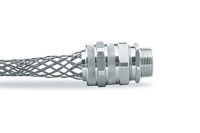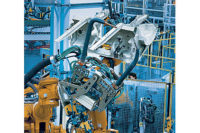Large, in-line continuous motion systems are often used for high-speed automated assembly. These systems can produce a large volume of products economically. However, one weakness of in-line systems is uptime. If one element of the system stops, the entire process stops, because it is often impractical to provide more than a short period of accumulation within the system.
High-speed machines use multiple workstations to perform intermittent operations. For example, four workstations may perform a task on parts that are stopped in front of them. A typical approach would have the parts indexed by four, or moved forward four times the spacing of the parts. Each workstation performs its task during a set dwell time before the next index cycle begins. If one of the workstations stops operating, then either the entire machine must be stopped to fix the problem, or 25 percent of the assemblies will be bad.
An approach called adaptive indexing can be used to position every part adjacent to exactly one workstation of each type as they pass through the working region. Adaptive indexing ensures this will happen despite a failure in one or more individual workstations. This system can often be integrated into existing indexing systems, or designed into a new machine. The adaptive indexer adjusts the index of a continuous line in an intelligent manner to guarantee that the workstations can perform all operations on every part.
An adaptive indexing system must include:
- A central control system.
- A device for indexing parts such that the dwell time, indexing distance and overall cycle time can be adjusted by the control system.
- Assembly stations that can be enabled and disabled by the control system. Workstations should be safely accessible by the operators so that jams and failures can be cleared without stopping the machine.
- Sensors to tell the control system the location of the parts relative to the workstations.
The central control system can detect when one of the stations is malfunctioning due to a jam, running out of material, or other failure. The control system will then adjust the index to a new distance. It may also enable or disable some workstations to ensure that all operations are performed on all parts.
For example, let's say an adaptive continuous indexing system includes a conveyor of equally spaced parts, and four workstations arranged to perform the same operation on four adjacent parts during the dwell time of the index. The conveyor indexes by four parts each cycle. If the workstation to the far right becomes jammed, the controller can adjust the index so that the conveyor indexes by three parts each cycle, so the operation is still performed on every part.
One of two things must also happen:
- If the line speed does not change, then the dwell time is reduced by 25 percent. The workstations must be capable of performing their operations 33 percent faster. This way, the disabled workstation will not affect the throughput of the machine. Because the workstations were not operating at their maximum speed, there was some extra capacity or redundancy in the system. This redundancy was converted to robustness by the adaptive indexer.
- If the workstations are operating at their maximum speed, then the line speed must be reduced by 25 percent. This will reduce the throughput of the overall line, but prevent many wasted parts. A machine producing 100 percent good parts at 75 percent speed is more useful than a machine producing 25 percent waste at 100 percent speed.
Adaptive continuous indexers should have workstations that allow operators to safely clear jams or refill parts while the machine continues to operate. This allows the machine to achieve greater uptime, because operators can usually reactivate a workstation long before another one fails.
Any number of workstations can be disabled on the edges of the set, as long as a subset of adjacent workstations exists with no gaps. For example, in a set of six workstations, the two on the right could be disabled, leaving four continuous stations. Any continuous set of "N" workstations can perform operations on the entire line if the line is indexed by "N" each cycle.
More than one set of workstations may be used to perform different operations on the parts. In this case, the second set must also be reduced to the same number of operating workstations. The gap between the stations can be of any distance.
In addition, a set of workstations doing the same operation can have "G" number of stations disabled in the middle of it, breaking the set into two subsets of size A and B. This arrangement will perform operations on the full line if:
- The line is indexed by a length of A + B.
- The gap, G, is equal to N x (A + B), where N is any whole integer.
The adaptive indexer can be used to make sure that parts are positioned near one workstation, or one of each type of workstation, despite a failure in one or more of the workstations. Without this system, the machinery would have to shut down while operators fix the problem, reducing the uptime of the machine or increasing the waste. With this system only a few bad products are produced as the index is adjusted. After the first cycle, all products will receive all operations.

